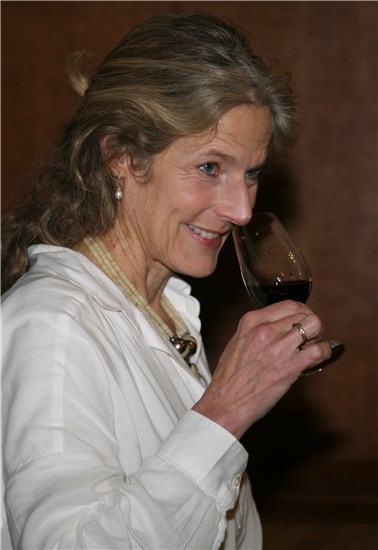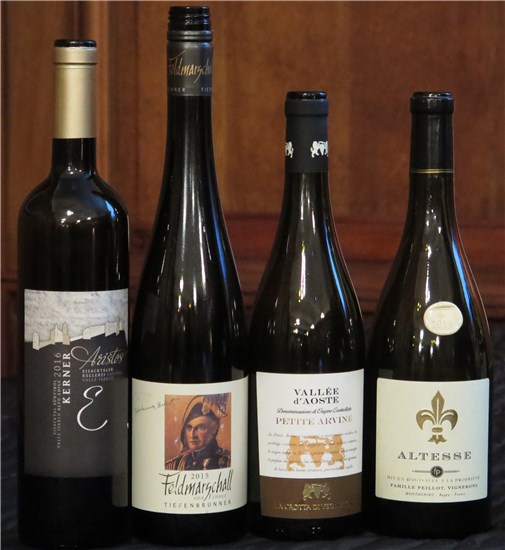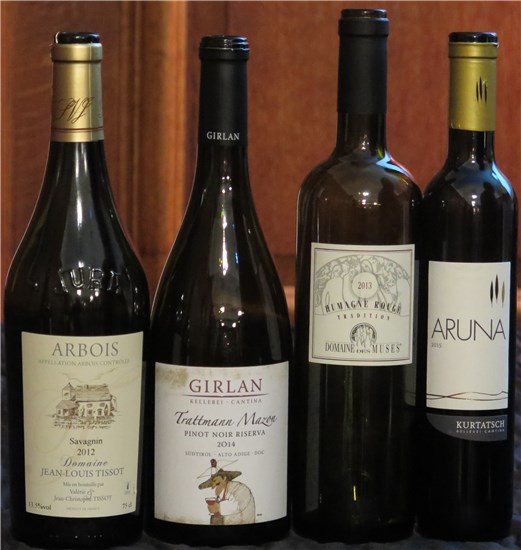 ‘Mountain Wines’ was the title and mountain wines we got. Eight fascinating wines from the Alto Adige, Val d’Aosta, Switzerland, the Savoy and Jura. Collectively and individually they were a perfect expression of the Club’s mission: wines you couldn’t or wouldn’t taste on your own account. Our thanks are due not just to our presenter but to the Alto Adige Consorzio which provided many of the wines for free.
‘Mountain Wines’ was the title and mountain wines we got. Eight fascinating wines from the Alto Adige, Val d’Aosta, Switzerland, the Savoy and Jura. Collectively and individually they were a perfect expression of the Club’s mission: wines you couldn’t or wouldn’t taste on your own account. Our thanks are due not just to our presenter but to the Alto Adige Consorzio which provided many of the wines for free.
And we had a perfect guide to these wines. Nancy Gilchrist MW knows the area and knows the wines and presented a compelling case for the importance of the mountain vineyards of the world as climate change takes effect. As conditions get warmer, it becomes harder and harder to find stylish, elegant wines (and the traditional fine wine areas of Europe are increasingly threatened by hail and storms). Growing higher up the slopes is one answer: each 100 metres of extra height sees an average temperature fall of 0.65 degrees. Another way of putting it is that 100 metres of extra height is equivalent to moving a European vineyard 45 miles closer to the North Pole.
What’s more these regions have a reservoir of largely unknown and barely exploited grapes that represent (in Nancy’s words) ‘an Amazonian basin of grape stocks’. In a James Bond-style lab carved out of the mountain in Laimburg serious research is going on into high altitude farming – and vines are a prime target.
There are problems to overcome of course. Holdings are small and mountain viticulture is tough work. To get the grapes from the field to the winery in some areas they use helicopters; in others they are lowered in buckets by rope. Much of the labour is part-time: office job in the morning, vineyard in the afternoon. Will the next generation of sons and daughters be prepared to take on that role? But what wines they produce!
 First off, we tasted a pair of whites from the Alto Adige (grown in the hills around Bolzano). Wine no. 1 was the 2016 Aristos, made from the Kerner grape by the Valle Isarco Cantina (i.e co-op). Kerner is a cross of Riesling and Red Schiava (local to the Alto Adige) that’s grown on limestone around 8-900 metres high. Bolzano has impressively high levels of average temperature (warmer than Naples on a year round basis) and the altitude is necessary to counteract any tendency to flabbiness. The wine was one of Decanter’s Top 20 last year and had a fabulous nose of candied citrus with a touch of ginger and some floral notes (almost a hint of Gewurz about the nose). There’s no oak involved but it spends time on the lees and the resultant blend of rich mouthfeel, good acidity, strong minerality and well-carried 14.5% alcohol, was a treat. £23.95 from Slurp.
First off, we tasted a pair of whites from the Alto Adige (grown in the hills around Bolzano). Wine no. 1 was the 2016 Aristos, made from the Kerner grape by the Valle Isarco Cantina (i.e co-op). Kerner is a cross of Riesling and Red Schiava (local to the Alto Adige) that’s grown on limestone around 8-900 metres high. Bolzano has impressively high levels of average temperature (warmer than Naples on a year round basis) and the altitude is necessary to counteract any tendency to flabbiness. The wine was one of Decanter’s Top 20 last year and had a fabulous nose of candied citrus with a touch of ginger and some floral notes (almost a hint of Gewurz about the nose). There’s no oak involved but it spends time on the lees and the resultant blend of rich mouthfeel, good acidity, strong minerality and well-carried 14.5% alcohol, was a treat. £23.95 from Slurp.
Wine no. 2 was a 2015 Tiefenbrunner Muller Thurgau from Feldmareschall Von Fenner. Grown at over 1000 metres, this was a deeper lemon in colour with a strong and persistent note of gunflint / sulphur (not to everyone’s taste). Muller Thurgau (a nineteenth-century cross between Riesling and Madeleine Royal) is prolific and rarely given the care and attention needed to produce a wine of concentration and weight such as this example which is made as an act of homage to Herbert Tiefenbrunner, a long-time pioneer of, and advocate for, the wines of the Alto Adige. For Nancy this was the most exciting M-T she has ever had and it clearly had the ingredients for a considerable further maturation. £31.85 from Tannico.
For wine no. 3 we moved west to the Val d’Aosta. This was a 2016 Petite Arvine, produced by La Crotta di Vegneron, another co-op based around a small group of family smallholders. This was a complete contrast in style to the two previous wines: slightly deeper yellow with a touch of green, a nose which had notes of vanilla and cream alongside nectarine, honey and citrus. High alcohol and high acidity characterise this early budding and late-ripening grape. Frost and hail can be a problem in spring whilst late summer storms test the growers’ nerves. Yet this is a grape that has been grown up here in Europe’s smallest and highest vineyard area for at least two millennia. £12.95 from the Wine Society.
Wine no. 4 took us over the border into the Savoy for a 2016 Roussette du Bugey-Montagnieu grown by Domaine Peillot, a small family vineyard near Bugey (the home of Brillat-Savarin, the gourmet’s gourmet). Also known as Altesse, Roussette is often paired with Chardonnay and the region makes excellent sparkling wines. This was a still example though, with a distinctive nose that started with camomile and grapefruit and slowly opened into a rich citrus. There was no evident oak (though the wine is fermented in large old oak casks) and malolactic had been blocked to ensure a wine of excellent freshness (only 12% alcohol), delicacy and elegance, somewhat similar to Furmint in character. £16 from the Wine Society.
 Wine no 5 was the last of the dry whites. This was a 2012 Savagnin from Domaine Jean-Louis Tissot in the Jura appellation of Arbois (probably the oldest in France). Though some Savagnin is made ‘au natur’ this was an example of the traditional, highly-oxidised style. Easily mistaken for a Fino or Manzanilla (only the lower alcohol gives it away in blind tastings), this has walnuts on the nose and a salty intensity in the mouth. Unlike the hyper-traditional Vin Jaune of this region, this particular Savagnin is not solera-aged but takes its character from flor-influenced oak vats. Also grown in Switzerland under the names of Heida and Païen, Savagnin is probably related to Viognier – another grape that Nancy reckoned would often benefit from a bit more altitude and less flabbiness. £17.75 from Yapp.
Wine no 5 was the last of the dry whites. This was a 2012 Savagnin from Domaine Jean-Louis Tissot in the Jura appellation of Arbois (probably the oldest in France). Though some Savagnin is made ‘au natur’ this was an example of the traditional, highly-oxidised style. Easily mistaken for a Fino or Manzanilla (only the lower alcohol gives it away in blind tastings), this has walnuts on the nose and a salty intensity in the mouth. Unlike the hyper-traditional Vin Jaune of this region, this particular Savagnin is not solera-aged but takes its character from flor-influenced oak vats. Also grown in Switzerland under the names of Heida and Païen, Savagnin is probably related to Viognier – another grape that Nancy reckoned would often benefit from a bit more altitude and less flabbiness. £17.75 from Yapp.
Then we moved to a pair of reds, tasting first the 2013 Humagne Rouge from the Domaine des Muses made in the Swiss area of Valais. To put it simply the nomenclature and origins of Humagne Rouge are both disputed and fiendishly complicated – if you want to know more look it up in the Robinson / Vouillamoz / Harding blockbuster, Wine Grapes. Humagne Rouge is thick-skinned and the wine is often dismissed as ‘rustic’, good with raclette and not much else. Not this example though. Deep in colour, a nose of damson and strawberry with herbs and a touch of violet in the mix. The vibrancy of the colour, Nancy told us, is partly down to high altitude and the UV intensity. Lovely stuff. £33 from Wine Society.
The second red took us back into the Alto Adige for Trattmann Mazon‘s 2014 Pinot Noir Riserva from the Cantina Girlan. Already paling in colour but far from fragile this had an unmistakeable Pinot nose of red fruit, overlain in this case with toasty (almost Bourbon-cask) oak, high acidity and silky tannins. Finer tannins, Nancy reckoned, are linked to high altitude wines, probably because of the longer hang-time required in the mountains for full ripeness. A vibrant, elegant and delicious example of Pinot, this wine could probably go another 6-8 years and its quality has been recognised by many awards. £29.78 from Tannico.
 Last wine of the night was, for many people, the stand-out star. This was the 2015 Gewurztraminer-Goldmuskateller, 'Aruna', a Bianco Passito from Cantina Kurtatsch in the Alto Adige. This blend of Gewurz and Moscato Giallo features a co-fermentation. The Muscat is picked in October and dried into raisins (the ‘passito’ element of the name); the Gewurz picked in early December. The end result is a wine with an extraordinarily complex and appealing nose. Honey and ginger, honeysuckle, lime and white pepper – all those and more. In the mouth luscious yet with brisk acidity and great elegance on the finish. Like many of the regions featured in this excellent tasting the vineyards are essentially organic, often bio-dynamic. The height and cold nights mean lower levels of rainfall and very few bugs. Probably around £25 for a half bottle. May be stocked by Haynes, Hanson and Clark in the future; possibly available at Exel Wines in Scotland.
Last wine of the night was, for many people, the stand-out star. This was the 2015 Gewurztraminer-Goldmuskateller, 'Aruna', a Bianco Passito from Cantina Kurtatsch in the Alto Adige. This blend of Gewurz and Moscato Giallo features a co-fermentation. The Muscat is picked in October and dried into raisins (the ‘passito’ element of the name); the Gewurz picked in early December. The end result is a wine with an extraordinarily complex and appealing nose. Honey and ginger, honeysuckle, lime and white pepper – all those and more. In the mouth luscious yet with brisk acidity and great elegance on the finish. Like many of the regions featured in this excellent tasting the vineyards are essentially organic, often bio-dynamic. The height and cold nights mean lower levels of rainfall and very few bugs. Probably around £25 for a half bottle. May be stocked by Haynes, Hanson and Clark in the future; possibly available at Exel Wines in Scotland.
A wonderful tasting!
GH: 30/11/17